
The Bay of Fundy is a bay between the Canadian provinces of New Brunswick and Nova Scotia, with a small portion touching the U.S. state of Maine. Its extremely high tidal range is the highest in the world. The name is likely a corruption of the French word fendu, meaning 'split'.
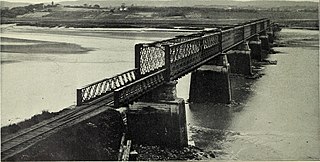
The Avon River is a small river in central Nova Scotia, Canada.

A tidal bore, often simply given as bore in context, is a tidal phenomenon in which the leading edge of the incoming tide forms a wave of water that travels up a river or narrow bay reversing the direction of the river or bay's current.
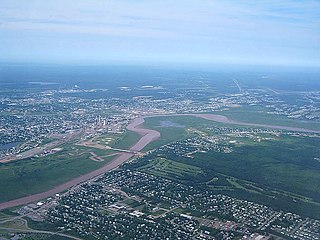
The Petitcodiac River, known informally as the Chocolate River, is a river in south-eastern New Brunswick, Canada. It is characterized by its brown mud floor and brown waters. The river has a meander length of 79 kilometres and is located in Westmorland, Albert, and Kings counties, draining a watershed area of about 2,071 square kilometres (800 sq mi). The watershed features valleys, ridges, and rolling hills, and is home to a diverse population of terrestrial and aquatic species. Ten named tributaries join the river in its course toward its mouth in Shepody Bay. Before the construction of a causeway in 1968, the river had one of the world's largest tidal bores, which ranged from 1 to 2 metres (3.3–6.6 ft) in height and moved at 5 to 13 kilometres per hour (3.1–8.1 mph). With the opening of the causeway gates in April 2010, the river is flushing itself of ocean silts, and the bore is returning to its former size.
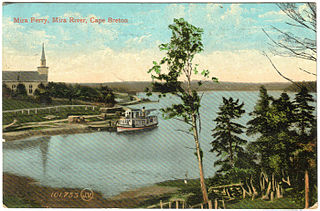
The Mira River is a Canadian river located in eastern Cape Breton Island, Nova Scotia.

The Annapolis River is a Canadian river located in Nova Scotia's Annapolis Valley.

The Shubenacadie River is a river in Nova Scotia, Canada. It has a meander length of approximately 72 km from its source at Shubenacadie Grand Lake to its mouth at the historic seaport village of Maitland on Cobequid Bay, site of the building of the William D. Lawrence, the largest wooden ship ever built in Canada. In 2009, the I Backpack Canada blog named the Shubenacadie one of the top five whitewater rivers in Canada. The lower 30 km of the river is tidal and the river experiences a tidal bore twice daily, with some bores reaching up to 3 m in height at certain points along the river. Local tourism operators offer adventure seekers a chance to ride with the bore on high-horse power Zodiac Hurricanes. Tidal Bore Rafting was invented at the Tidal Bore Rafting Resort by H. Knoll. It is also a popular surfing spot for experienced Sea Kayakers.
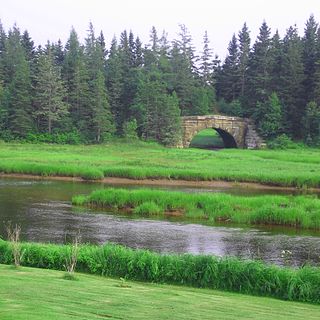
The Tidnish River is a short Canadian river on the Isthmus of Chignecto along the interprovincial boundary with New Brunswick and Nova Scotia.
The River Hebert is a small tidal river that empties into the Cumberland Basin, and is contained completely within Cumberland County, Nova Scotia. According to estimates by the Province of Nova Scotia, there were 9,092 people resident within the Maccan/Kelley/Hebert watershed in 2011.

The Cornwallis River is in Kings County, Nova Scotia, Canada. It has a meander length of approximately 48 kilometres (30 mi) through eastern Kings County, from its source on the North Mountain at Grafton to its mouth near Wolfville on the Minas Basin. The lower portion of the river beginning at Kentville is tidal and there are extensive tidal marshes in the lower reaches. In its upper watershed at Berwick, the river draws on the Caribou Bog while a longer branch continues to the official source, a stream on the North Mountain at Grafton.

River John is a river in Nova Scotia. Draining the extreme western part of Pictou County, it flows into Amet Sound on the Northumberland Strait at River John, a village which takes its name from the river. The Miꞌkmaq name is Kajeboogwek. An early name was Deception River. Its present name is believed to derive from Rivière Jaune, an Acadian name, though it may also derive from nearby Cap Jean. DesBarres called it River John in his Atlantic Neptune.
The Maccan River is a small tidal river contained completely within Cumberland County, Nova Scotia. The river terminates at the confluence of River Hebert at Amherst Point, and empties into the Cumberland Basin. The river's tidal bore may be viewed from the Tidal Wetlands Park in Maccan. According to estimates by the Province of Nova Scotia, there are 9,092 people resident within the Maccan/Kelly/Hebert watershed in 2011.

The St. Croix River is a river in Nova Scotia entirely contained in Hants and Halifax Counties. Its headwaters are Panuke Lake. The river has been exploited for water power. There were water mills in the nineteenth century and in the 1930s three hydroelectric dams were built; they still operate.

Kennetcook is a community in the Canadian province of Nova Scotia, located in the Municipal District of East Hants. Also see adjacent community of Upper Kennetcook.

Apple River is a community in the Canadian province of Nova Scotia, located in Cumberland County.

Portapique is a rural community in the Canadian province of Nova Scotia, located in Colchester County. It has about 100 residents in winter and increases to 250 residents in summer.
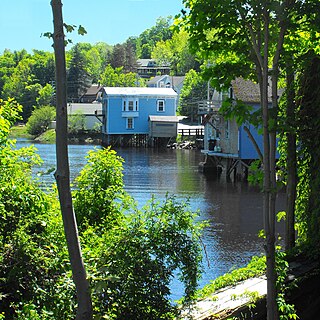
The Bear River is a minor river in western Nova Scotia, Canada. Flowing from south to north, it is 40 kilometres (25 mi) long from its headwaters to its discharge into the Annapolis Basin, some 6 kilometres (3.7 mi) east of Digby. The river is tidal for the last 9.7 kilometres (6.0 mi) of its length. The village of Bear River is situated near the head of the tide where shipbuilding took place in the nineteenth century.
The Canard River is a river in Kings County, Nova Scotia, Canada which drains into the Minas Basin of the Bay of Fundy between the communities of Canard and Starr's Point. It is known for its fertile river banks and extensive dyke land agriculture.
Midland Railway was a Nova Scotian railway company formed in 1896 to build a railway through Hants County, Nova Scotia, connecting Truro to Windsor. Completed in 1901, it operated independently until 1905 when it became part of the Dominion Atlantic Railway and later the Canadian Pacific Railway, until the line closed in 1983.

The Gaspereau River is a river in Kings County, Nova Scotia, Canada.















